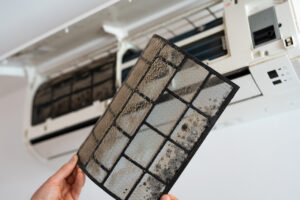 You suspect there is already mold behind the walls of your kitchen as you start seeing discoloration on the walls, and it is spreading. There is also a musty smell that just won’t go away.
You suspect there is already mold behind the walls of your kitchen as you start seeing discoloration on the walls, and it is spreading. There is also a musty smell that just won’t go away.
Mold is characterized by its cotton-like features which may be gray, white, black, or green. Black mold can be especially dangerous, so be sure to watch for any sign of this type of growth.
Can I Use a Self Test Kit From The Store?
Though you’re fairly certain it is mold, you still want to test for it.
You can do your own assessment by using home mold test kits. These do-it-yourself kits are sold with claims that they can pinpoint the presence of harmful molds that can trigger serious health problems.
However, home testing tools are not considered statistically accurate and they produce a large number of false positives. A false positive means the home test will claim you have a mold problem when you don’t actually have elevated levels of mold.
If you are concerned enough, you’d ideally contact a professional. They have the proper tools to conduct air sampling and lift sampling as the situation requires.
Types of Mold Testing
Here are the different types of mold testing which may be conducted by a mold professional as part of the remediation process.
- Air Sampling.Using air sampling, mold experts collect indoor air samples from the home. A control sample is also taken outside of the home. A comparison is made between the between the indoor and outdoor samples to determine if there are elevated levels of mold spores inside the home that are not naturally present in the outdoor environment.
- Lift Tape Sample. A piece of tape placed onto any areas to be tested. It is then lifted and placed on a glass micro slide. The tape slide is then sealed and examined by the microbiology laboratory for mold spore presence
- Tape Swab Test. This test is used infrequently because it is used to determine which type of mold is present. This test does not typically identify spore count, which is essential to determining if there are elevated levels of mold in a home. Because all mold requires remediation, the mold spore counts are far more important than the actual types of mold. The tape swab test uses a cotton material swab to wipe the surface to be tested. After touching surfaces, the swab is sent to a lab for examination.
Why is Pre- and Post-testing Important?
Pre-testing usually starts as testing to determine if there is a problem. If the initial testing determines there is a problem, then the pre-test results are useful in assisting in the development of the scope of work.
Post-testing is a best practice as defined in the S520 standards manual published by the IICRC. Post-testing provides reassurance to the property owner and proof for the contractor that the work was completed properly. In smaller remediation projects, or where the scope of work is outside the normal living space of the home, many homeowners decline a post-test to save money.
Restoration experts always prefer post-testing. A clear Post-test report is provided to protect all parties involved in the mold removal project. The Post-test report becomes a valuable document when you want to sell your property.
Recommendations
When you should conduct mold testing:
- When water-related problems occur
- Suspected microbial growth—musty odors
- Visible signs of mold growth
- Chronic respiratory illnesses
- Documentation to support the need for remediation work
- Documentation to confirm that remediation work was properly completed
The key to preventing mold is awareness of the problem. Be vigilant with your surroundings and check for any signs of mold growth. Early prevention is the best solution to all the hazards inflicted by this microorganism. Call us for a consultation and inspection.







